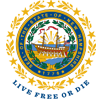Barcode Basics
How library barcodes work.
Most library barcodes are codabar barcodes, including ones that libraries purchased in the past through NHAIS Services. Codabar barcodes have 14 digits and the information included in the numbers tells you what the barcode is for.
The first digit indicates the type of barcode; 2 indicates a patron barcode, 3 indicates a material barcode
The next 4 digits identify the institution the barcode belongs to. A unique barcode identifier was assigned to each library in New Hampshire so that (if libraries use their standardized barcode numbers) each library will have a unique set of numbers for both materials and patrons. This is useful for identifying materials that go astray, preventing libraries from accidentally checking in someone else's materials, and facilitating online systems where patrons identify themselves by their barcode number.
The next 8 digits are numbers that identify a specific item or person, usually printed in sequential order. Patrons 00000001-99999999 for example.
The final digit is a check digit and is typically expressed as an X in a sequence of numbers, on a barcode order for example. Barcodes purchased through NHAIS services use the mod 10 algorithm to calculate the check digit.
Institution Identifiers Assigned to NH Libraries for Barcodes



